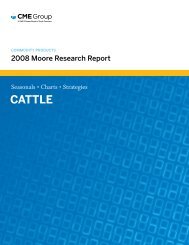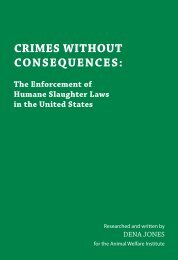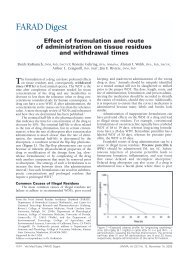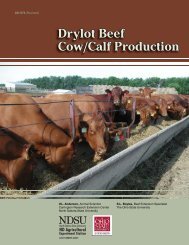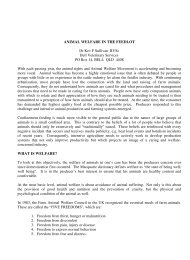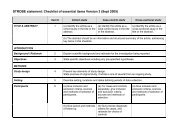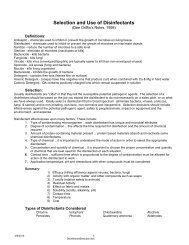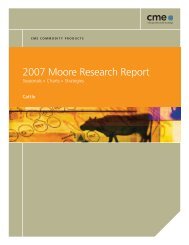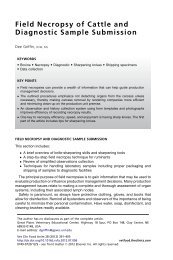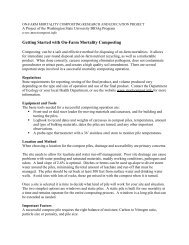Effect of management strategies on reducing heat stress of feedlot ...
Effect of management strategies on reducing heat stress of feedlot ...
Effect of management strategies on reducing heat stress of feedlot ...
You also want an ePaper? Increase the reach of your titles
YUMPU automatically turns print PDFs into web optimized ePapers that Google loves.
3078<br />
1993). Altering feeding time and/or amount have been<br />
shown to be beneficial in <strong>reducing</strong> <strong>heat</strong> <strong>stress</strong> (Brosh<br />
et al., 1998). Feeding cattle later in the day prevents<br />
the coincidal occurrence <str<strong>on</strong>g>of</str<strong>on</strong>g> peak metabolic and envir<strong>on</strong>mental<br />
<strong>heat</strong> load (Reinhardt and Brandt, 1994; Brosh<br />
et al., 1998). Limiting energy intake can effectively decrease<br />
basal metabolic <strong>heat</strong> producti<strong>on</strong> (Carstens et al.,<br />
1989) and therefore decrease total metabolic <strong>heat</strong> load<br />
<str<strong>on</strong>g>of</str<strong>on</strong>g> animals subjected to high envir<strong>on</strong>mental temperatures.<br />
Furthermore, energy restricti<strong>on</strong> programs have<br />
resulted in improved efficiency <str<strong>on</strong>g>of</str<strong>on</strong>g> cattle maintained under<br />
therm<strong>on</strong>eutral envir<strong>on</strong>ments (Murphy and<br />
Loerch, 1994).<br />
Davis et al. (2003) reported that altering feeding regimen<br />
and/or sprinkling cattle significantly decreased<br />
<strong>feedlot</strong> cattle <strong>heat</strong> <strong>stress</strong>, as determined from tympanic<br />
temperature. The objectives <str<strong>on</strong>g>of</str<strong>on</strong>g> these studies were to<br />
evaluate the strategic use <str<strong>on</strong>g>of</str<strong>on</strong>g> altered feeding times and<br />
amounts both apart from and in additi<strong>on</strong> to provisi<strong>on</strong><br />
<str<strong>on</strong>g>of</str<strong>on</strong>g> sprinklers <strong>on</strong> <strong>feedlot</strong> steers finished in the summer<br />
m<strong>on</strong>ths.<br />
Materials and Methods<br />
All experiments reported herein were c<strong>on</strong>ducted at<br />
the University <str<strong>on</strong>g>of</str<strong>on</strong>g> Nebraska Haskell Agricultural Laboratory<br />
with the approval <str<strong>on</strong>g>of</str<strong>on</strong>g> the University <str<strong>on</strong>g>of</str<strong>on</strong>g> Nebraska-<br />
Lincoln Instituti<strong>on</strong>al Animal Care and Use Committee.<br />
Facility design and layout has been reported by Mader<br />
et al. (1997, 1999a). Facilities are located at lat 42°23′<br />
N and l<strong>on</strong>g 96°57′ W, with a mean elevati<strong>on</strong> <str<strong>on</strong>g>of</str<strong>on</strong>g> 445<br />
m above sea level. Details <str<strong>on</strong>g>of</str<strong>on</strong>g> the vaccinati<strong>on</strong>, parasite<br />
c<strong>on</strong>trol, and implant regimens utilized for these experiments<br />
are reported by Davis et al. (2003). Experimental<br />
design, sprinkling procedures, and climate data were<br />
also reported by Davis et al. (2003). Procedures used<br />
to obtain carcass data are described by Mader and Lechtenberg<br />
(2000). In all experiments, individual initial<br />
weight was the average <str<strong>on</strong>g>of</str<strong>on</strong>g> two n<strong>on</strong>shrunk weights<br />
taken <strong>on</strong> c<strong>on</strong>secutive days (d −1 and 0).<br />
Experiment 1<br />
On June 23, 144 Angus × Charolais crossbred steers<br />
were randomly assigned to <strong>on</strong>e <str<strong>on</strong>g>of</str<strong>on</strong>g> 24 pens (six steers<br />
per pen). Treatments assigned to pens (eight pens per<br />
treatment) were as follows: 1) providing ad libitum access<br />
to feed at 0800 (ADLIB); 2) providing feed at 1600<br />
with amount adjusted so that n<strong>on</strong>e was available at<br />
0800 (BKMGT); and 3) providing feed at 1600 at 85%<br />
<str<strong>on</strong>g>of</str<strong>on</strong>g> predicted ad libitum levels (LIMFD). All steers were<br />
adjusted to the diet being fed, over a 21-d period, before<br />
initiati<strong>on</strong> <str<strong>on</strong>g>of</str<strong>on</strong>g> this experiment. The DMI by steers in the<br />
LIMFD treatment group was determined before initiati<strong>on</strong><br />
<str<strong>on</strong>g>of</str<strong>on</strong>g> the study and was based <strong>on</strong> projected gain and<br />
associated daily DMI <str<strong>on</strong>g>of</str<strong>on</strong>g> comparable cattle <str<strong>on</strong>g>of</str<strong>on</strong>g>fered feed<br />
ad libitum using computer s<str<strong>on</strong>g>of</str<strong>on</strong>g>tware (NRC, 1996), based<br />
<strong>on</strong> breed type, age, body c<strong>on</strong>diti<strong>on</strong>, frame size, and diet.<br />
Ingredient and nutrient compositi<strong>on</strong> <str<strong>on</strong>g>of</str<strong>on</strong>g> the diet in this<br />
Mader and Davis<br />
Table 1. Ingredient and nutrient compositi<strong>on</strong> <str<strong>on</strong>g>of</str<strong>on</strong>g> diets fed<br />
during Exp. 1, 2, and 3<br />
Item Exp. 1 and 2 Exp. 3<br />
%, DM basis<br />
Ingredients<br />
Dry-rolled corn 84.00 81.00<br />
Alfalfa hay 7.50 5.00<br />
Corn silage — 5.00<br />
Soybean meal 2.00 2.50<br />
Liquid supplement a<br />
4.50 4.50<br />
Dry supplement b<br />
Compositi<strong>on</strong><br />
2.00 2.00<br />
c<br />
CP, % 13.0 13.0<br />
NEm, Mcal/kg 2.10 2.10<br />
ME, Mcal/kg 3.08 3.08<br />
NEg, Mcal/kg 1.43 1.43<br />
Ca, % 0.70 0.70<br />
P, % 0.34 0.33<br />
K, % 0.75 0.76<br />
a C<strong>on</strong>tained <strong>on</strong> a DM basis: 61.54% CP; 12.30% Ca; 5.39% salt;<br />
3.85% K; 0.71% P; 0.43% Mg; 0.148% Zn; 0.037% Fe; 0.050% Mn;<br />
0.021% Cu; 0.002% I; 0.001% Co; 7 × 10 4 IU/kg vitamin A; 1 × 10 4<br />
IU/kg vitamin D; and 44 IU/kg vitamin E.<br />
b C<strong>on</strong>tained <strong>on</strong> a DM basis: 50.01% soybean meal; 48.57% ground<br />
corn; 0.85% Rumensin 80 (176.4 g <str<strong>on</strong>g>of</str<strong>on</strong>g> m<strong>on</strong>ensin/kg; Elanco Animal<br />
Health, Indianapolis, IN); 0.51% Tylan 40 (89 g <str<strong>on</strong>g>of</str<strong>on</strong>g> tylosin/kg; Elanco<br />
Animal Health); and 0.06% thiamine m<strong>on</strong><strong>on</strong>itrate.<br />
c Calculated compositi<strong>on</strong> (NRC, 1996).<br />
and subsequent experiments are shown in Table 1.<br />
Treatments were imposed for a 23-d managed feeding<br />
phase, after which all steers were fed ad libitum at<br />
0800 h. A 23-d managed feeding phase was used to<br />
corresp<strong>on</strong>d with the period <str<strong>on</strong>g>of</str<strong>on</strong>g> time cattle were adapting<br />
to summer <strong>heat</strong>, typically late June and the first few<br />
weeks <str<strong>on</strong>g>of</str<strong>on</strong>g> July, and the more <strong>stress</strong>ful porti<strong>on</strong> <str<strong>on</strong>g>of</str<strong>on</strong>g> the<br />
summer (Mader et al., 1999a). A short managed feeding<br />
period was used because minimal use <str<strong>on</strong>g>of</str<strong>on</strong>g> alternative<br />
feeding systems is preferred to the norm in most feeding<br />
operati<strong>on</strong>s.<br />
Daily feed was recorded. Water meters (model C700,<br />
ABB Water Meters, Inc., Ocala, FL) were used to record<br />
daily water intake when bunks were read before feeding.<br />
Body weights were obtained <strong>on</strong> d 23 and 82 (experiment<br />
terminati<strong>on</strong>). On d 83, steers were slaughtered<br />
at a commercial slaughter facility where hot carcass<br />
weight, 12th-rib fat thickness, marbling score, and yield<br />
grade were obtained. Each pen shares a waterer and<br />
mound with an adjoining pen; therefore, for this and<br />
subsequent experiments, treatments were randomly<br />
assigned to sets <str<strong>on</strong>g>of</str<strong>on</strong>g> two pens, which shared a waterer<br />
and a mound.<br />
Experiment 2<br />
On June 23, 96 Angus × Charolais crossbred steers<br />
were randomly assigned to <strong>on</strong>e <str<strong>on</strong>g>of</str<strong>on</strong>g> 12 pens (eight steers<br />
per pen). Treatments assigned to pens (four pens per<br />
treatment) were as follows: 1) no water sprinkling<br />
(CON); 2) sprinkling <str<strong>on</strong>g>of</str<strong>on</strong>g> pen surface from 1000 to 1200<br />
(AM); and 3) sprinkling <str<strong>on</strong>g>of</str<strong>on</strong>g> pen surface from 1400 to 1600




